Oh Hey New Guide Thinggg~ Some Basics On How To Practice! There’s SO Much I Could Add To This, So It’s
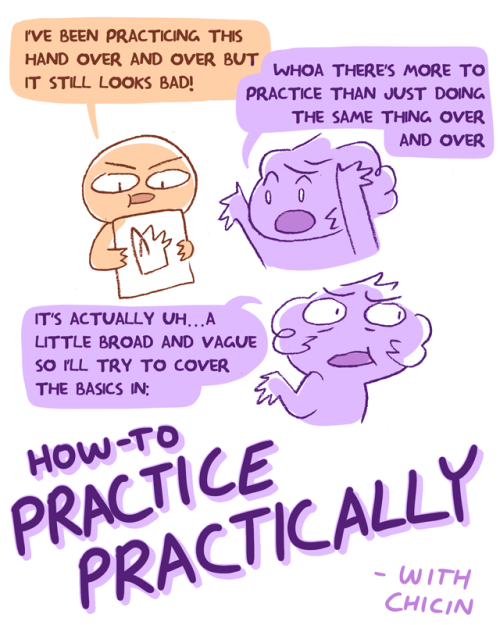
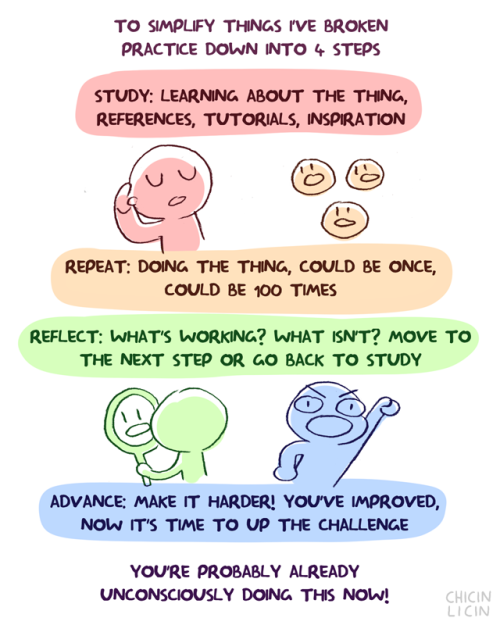



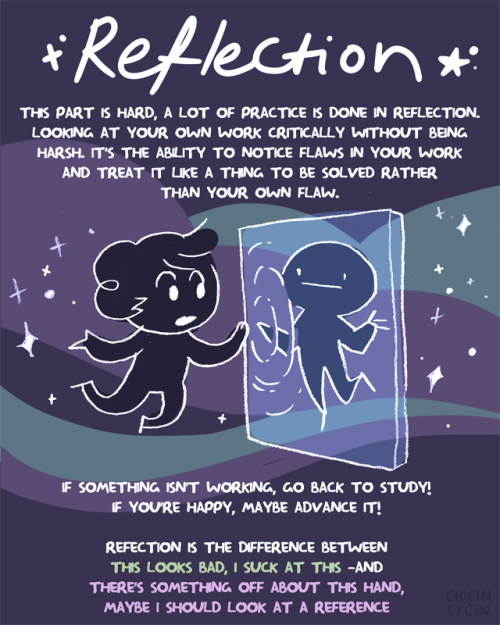
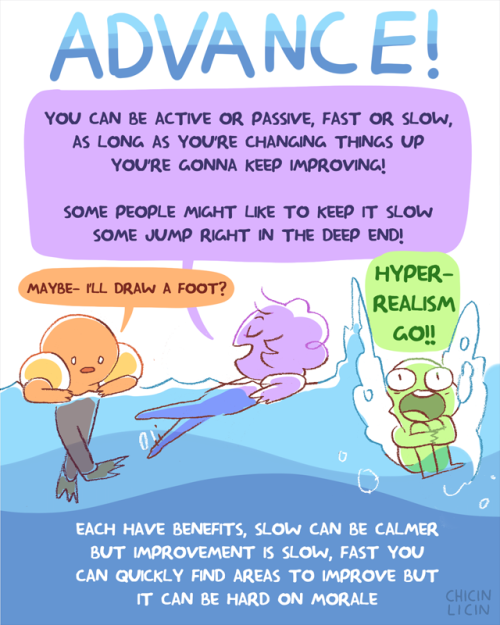
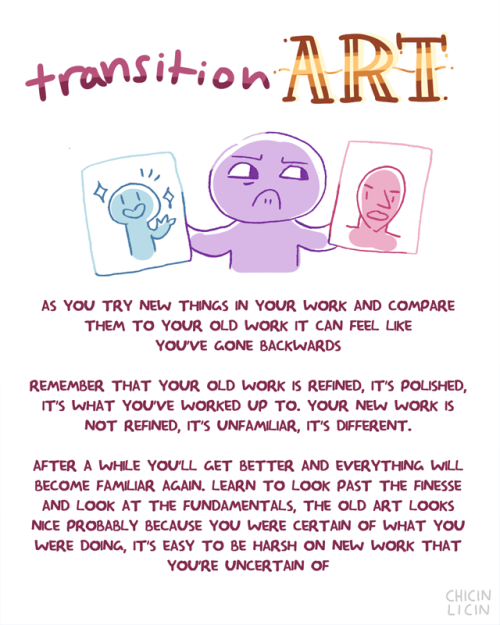
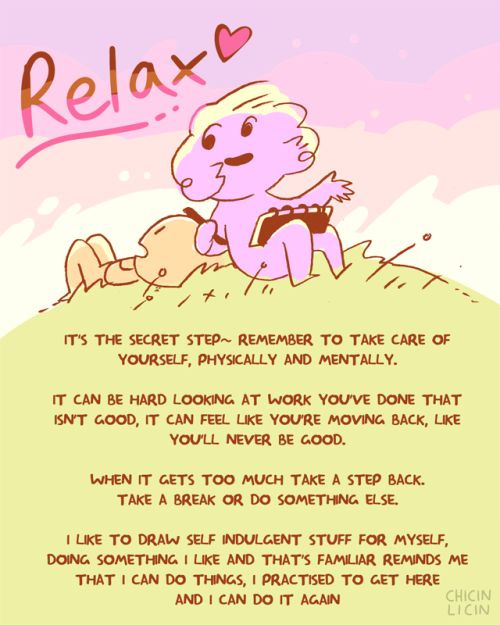
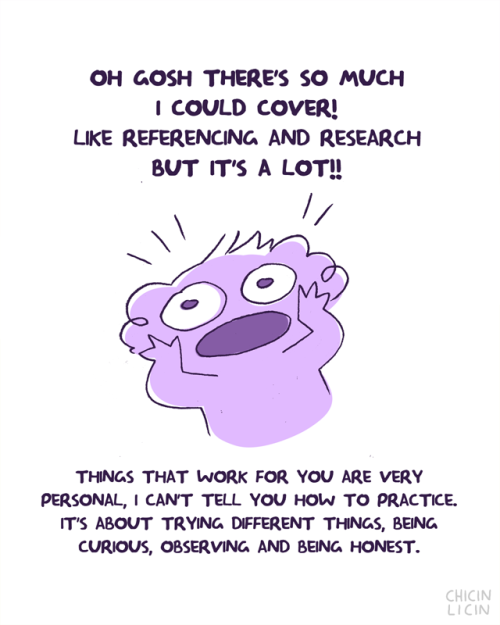
oh hey new guide thinggg~ some basics on how to practice! there’s SO much I could add to this, so it’s just the basics :O
short (kind of): there’s more to practice than doing something repeatedly, it’s also learning new things, problem solving, and honest critique. Each of those is its own skill…also be nice to yourself!
More Posts from Basket-of-references and Others
Digital Painting: tips for beginners
Heyo! I got asked if I could make a tutorial on digital painting so I’m gonna throw together some advice meant for people who are starting out and want to figure out exactly how this stuff all works. Because it’s hard! What I hope to accomplish here is to make painting more approachable for you.
Firstly, I have put together something like this before, so for archival purposes here it is: http://holy-quinity.tumblr.com/post/89594801811/i-dont-know-how-much-of-this-kind-of-thing-you
For those of you who don’t wanna bother reading that, here are the main points:
1. Learn your program and its tools, from brush properties to layer styles. And I mean learn them. Make a cheatsheet that shows you exactly what each button and scale does, both in isolation and in conjunction with other buttons and scales. Refer to this as much as possible until it is intuitive. The end goal is to know exactly what to do to your brush’s settings to achieve a given effect.
2. It’s perfectly okay to use your sketches, linearts, and other forms of line in your paintings. They can help guide the form and there’s no need to make something fully “lineless”! I never make things “lineless.”
3. Study other people’s art and try to think how they could have possibly achieved the effects they did. You can learn a lot just by observing and mentally recreating the process stroke by stroke—muscle memory is a powerful tool at your disposal. This becomes easier to do once you’ve started doing item 1 above.
OKAY!
So where the heck do you even begin?
What I’m gonna do is try to make digital painting as approachable as possible for someone who’s never really done it. The main idea here is that digital painting is just like real painting. So if you’ve ever done real painting, you already kinda know what’s coming.
I’m gonna assume you know the basics of digital art: you can sketch, line those sketches using layers and opacity changes, and fill the lines with color, maybe even opting to add some shading…and you’ll get something like this:

You know, cell-shaded, or maybe the shading’s blended, but you’ve still obviously a line drawing with color put down on layers beneath the lines.
The next intuitive step is to try going “lineless”…but when you remove the lines you get this:

idk about you but I’m laughing at how stupid this looks
When I was first teaching myself to paint digitally, I didn’t really know how to deal with this. Without lines, the form of the subject vanished or became a mess like the above. Even if I was meticulous and careful about placing down the color such that without the lines layer turned on, the shapes fit together, it didn’t look quite right. There’d be gaps, I wouldn’t know how to incorporate the subject into a background, the contrast wouldn’t be high enough, or it’d just in general look too much like a screenshot from Super Mario 64.
Painting requires a different process than the above. You’ll have to let go of some of your habits and conventions. Such as staying in the lines. Such as fully relying on the lines. Like, I love my lines, I love my sketches—but in painting, they are guides for form, and are not the form itself. So let me go through how I approach a given painting:

My painting process starts with a sketch (here a boring portrait for demonstrative purposes). I make the opacity of the sketch layer something like 30%, and then throw down my base colors on a new layer underneath. I’m not being meticulous about the sketch itself, because again it’s just meant to guide my placement of color. I’m also not meticulous about my placement of the color.
We’re essentially sketching with color. Because ultimately what we want is for the color to take on the form and shapes conveyed by the sketch.
There’s a lot going into this about how to use value, how to shade, how to use color, etc. that I’m kinda skipping over because it takes a lot of time to explain…but there are hundreds of tutorials out there on those topics so please, google around! I found some helpful tuts that way when I was starting out.
Something I find v useful is to keep selecting colors that already exist in your image for shading and hue adjustment. This is why I start with really blendy, low-opacity brushes when throwing down color on top of the background. I can then select colors within there that are a mix of the two.
For instance, I’ll select the color of the lines here:

…and use that to shade:

And maybe I’ll select one of the darker shades around his eye, but not the darkest, to make the shading a smoother gradient…and so on.
What I do in general at this point is go over the shapes and lines of the sketch. Such that I can turn off the sketch layer and see this:

I’m replacing the lines with shading and value. I’ll continue to do this as I keep adding color.

This is all super loose. I am not dedicated to any particular stroke. I just want the colors and shading and light source to be right. I’ll use overlay layers to boost contrast or add a hue.
Here are other examples where I used this process:


I am constantly changing brushes and brush settings as I paint. It really depends on what effect I want where. I am also constantly selecting new colors and applying or blending those in. I don’t believe in having some uniformly applied base color and then shading with only one or two…that’s what I’d do if I was cell-shading like the first drawing I showed you here, but painting should be about messing with color and opacity and blending to make millions of hues!
Good rule of thumb: Hard, opaque brushes for applying color. Soft, dilute brushes for blending colors. Sometimes hard, dilute brushes can make some cool blending effects! I personally prefer harder edges on my shading so that’s a brush I use often.
This is getting a bit long so I’m gonna split it up into multiple parts, but really what I want you to get from this is:
1. learn the tools at your disposal until they are intuitive
2. sketch and line are guides for form, not the form itself
3. rather, hue and value will produce the form
And of course, practice makes perfect!!! Every drawing you make, every painting you make, will bring you one step closer to the artist you want to be, and thus every drawing and every painting, no matter what, is a success.
i watched one (1) video on how to draw hands that changed my life forever. like. i can suddenly draw hands again

these were all drawn without reference btw. i can just. Understand Hands now (for the most part, im sure theres definitely inaccuracies). im a little baffled
![[1] Color Zones Of The Face [Tried To Find Source, I Think It’s Here ]](https://64.media.tumblr.com/82181df6330fcb3655a2e40c6c43287a/tumblr_or5nykhGCu1sm0kjdo1_500.png)
![[1] Color Zones Of The Face [Tried To Find Source, I Think It’s Here ]](https://64.media.tumblr.com/1703500f3e1292e370eda4d4cb761252/tumblr_or5nykhGCu1sm0kjdo2_1280.jpg)
[1] Color Zones of the Face [Tried to find source, I think it’s here ]
[2] Navate’s Skin Chart Supplement – the actual tutorials are: Section I: Skin Basics & Section II: Skin tones
Two brilliant skin tutorials. Do not use flat colors for skin! Underpainting is important for realistic, vivid skin. Remember, underneath your skin is fat, muscles, red blood, blue veins, bones.
Consider reblogging this to support the original artist. I recommend following them as well!
More Helpful links: Ask a Question/Request a Tut | Submit a Tutorial | Promote Your Art Commissions to +18.3 K Dashes | Stay Updated on DeviantArt! | Visit me @astrikos
Hello! I hope you dont mind me asking, but how do you draw those amazing black and white comics? (Coffee and The Goddess comics come to mind!) I love the way you do them and would love to know the process you go thru!
this is a pretty broad question and im guessing/hoping you meant “how do you color in black and white in your comics” so have a few random tips about values and paneling and stuff i guess







thank you



I made a mini tutorial on how I approach Those Face Angles in my art, for free!
I've got a few more mini tutorials on my patreon if you'd like to support me too :D Patreon Link!
btw with art when people say 'youve got to do it scared' 'youve got to draw bad' 'youre not gonna know how to do it until you do it' it sounds like bullshit but its true. 90% of art is just getting over the fear that it's not going to be good enough to deserve to be made in the first place. but you're here. you're alive and, with no need to justify that, you're going to make art. it's just part of being alive. you'll spend so long worrying you aren't doing it good enough that you'll look back and realized you didn't live a single day of it.
I forgot I have to be active here so here’s my Twitter tutorial on how to draw folds I made a while back to help a friend!






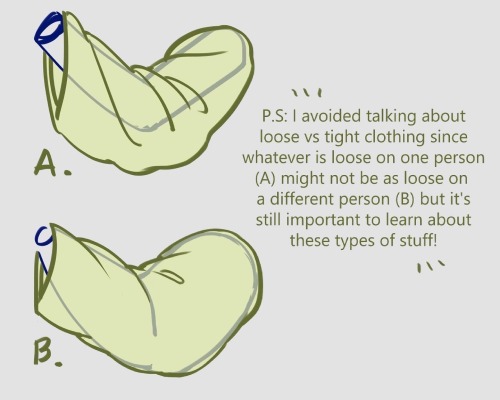


"and the centry owl stood guard, protector of all in need." TFE, S1E13
Love love love Nightshade's new form 🦉
I compiled a reference for all my artist homies, and myself~
-
 moonglobeatle liked this · 1 month ago
moonglobeatle liked this · 1 month ago -
 nikariarts reblogged this · 1 month ago
nikariarts reblogged this · 1 month ago -
 maggi-cube reblogged this · 1 month ago
maggi-cube reblogged this · 1 month ago -
 halusifreak liked this · 1 month ago
halusifreak liked this · 1 month ago -
 soch14 reblogged this · 1 month ago
soch14 reblogged this · 1 month ago -
 soch14 liked this · 1 month ago
soch14 liked this · 1 month ago -
 shadsmidnightthoughts liked this · 1 month ago
shadsmidnightthoughts liked this · 1 month ago -
 vtomleni reblogged this · 1 month ago
vtomleni reblogged this · 1 month ago -
 vtomleni liked this · 1 month ago
vtomleni liked this · 1 month ago -
 breebles5 reblogged this · 2 months ago
breebles5 reblogged this · 2 months ago -
 macchadoodles liked this · 2 months ago
macchadoodles liked this · 2 months ago -
 cahooseurcloor reblogged this · 2 months ago
cahooseurcloor reblogged this · 2 months ago -
 perry-88 liked this · 2 months ago
perry-88 liked this · 2 months ago -
 sparklewolfglitch liked this · 2 months ago
sparklewolfglitch liked this · 2 months ago -
 neocelticavalon liked this · 2 months ago
neocelticavalon liked this · 2 months ago -
 royalgardensnake liked this · 3 months ago
royalgardensnake liked this · 3 months ago -
 flarethedoodles reblogged this · 3 months ago
flarethedoodles reblogged this · 3 months ago -
 flaretheidiot liked this · 3 months ago
flaretheidiot liked this · 3 months ago -
 breebles5 reblogged this · 4 months ago
breebles5 reblogged this · 4 months ago -
 breebles5 liked this · 4 months ago
breebles5 liked this · 4 months ago -
 mayhemkitty23 reblogged this · 4 months ago
mayhemkitty23 reblogged this · 4 months ago -
 mayhemkitty23 liked this · 4 months ago
mayhemkitty23 liked this · 4 months ago -
 resources-for-artists reblogged this · 4 months ago
resources-for-artists reblogged this · 4 months ago -
 shaddow-reblogz reblogged this · 4 months ago
shaddow-reblogz reblogged this · 4 months ago -
 coriander-bat liked this · 5 months ago
coriander-bat liked this · 5 months ago -
 roseybloodlust reblogged this · 5 months ago
roseybloodlust reblogged this · 5 months ago -
 echo6307 reblogged this · 5 months ago
echo6307 reblogged this · 5 months ago -
 echo6307 liked this · 5 months ago
echo6307 liked this · 5 months ago -
 2904idk liked this · 5 months ago
2904idk liked this · 5 months ago -
 pullinguproots07 liked this · 5 months ago
pullinguproots07 liked this · 5 months ago -
 bramble-thomas liked this · 5 months ago
bramble-thomas liked this · 5 months ago -
 lochlaan reblogged this · 5 months ago
lochlaan reblogged this · 5 months ago -
 lochlaan liked this · 5 months ago
lochlaan liked this · 5 months ago -
 thealpha369 liked this · 5 months ago
thealpha369 liked this · 5 months ago -
 garlicfart liked this · 5 months ago
garlicfart liked this · 5 months ago -
 jollybean0 liked this · 5 months ago
jollybean0 liked this · 5 months ago -
 wingsforthewicked reblogged this · 5 months ago
wingsforthewicked reblogged this · 5 months ago -
 tinyevelyn liked this · 5 months ago
tinyevelyn liked this · 5 months ago





